
Tourism in Lebanon
Encyclopedia
The tourism industry in Lebanon
has been historically important to the local economy and remains to this day to be a major source of revenue for Lebanon. Before the Lebanese Civil War
, Beirut
was widely regarded as "The Paris of the Middle East," often cited as a financial and business hub where visitors could experience the Levant
ine Mediterranean
culture.
Lebanon's diverse atmosphere and ancient history make it an important destination which is slowly rebuilding itself after continued turmoil. Lebanon offers plenty: from ancient Roman
ruins, to well preserved castles, limestone caves, historic Churches and Mosques, beautiful beaches nestled in the Mediterranean Sea, world renown Lebanese cuisine
, nonstop nightlife and discothèques, to mountainous ski resorts.
Significant private investment is currently being made in the modernization and expansion of this sector and international hotel companies have returned to Lebanon. Casino du Liban
, which historically constituted a major tourist destination, reopened in 1996. Lebanon is the only country in the Arab
world that offers skiing and related winter sports activities. The largest ski resort in the country has been expanded and modernized. The Government believes that, because of the return of peace and stability to the country and with the development of the necessary infrastructure, tourism will again contribute significantly to Lebanon's economy. Lebanon's tourism industry also relies on the large number of Lebanese living abroad, who return regularly to the country during the summer season.
settlements to Phoenicia
n city-states, from Roman
temples to rock-cut hermitages
, from Crusader
Castles to Mamluk
mosques and Ottoman
hammam
s, the country's historical and archaeological sites are a true encyclopedia of ancient and modern world history.
Lebanon has a long standing history of cultural tourism
. Interest in the Lebanese
Levant
ine culture was stirred following the visits of many European orientalists, scholars and poets particularly Alphonse de Lamartine
, Ernest Renan
and Victor Guérin
.
Lebanon's cultural tourism
focal points are historic monuments, archaeological sites, cultural venues, traditional art, rural customs, religious festivals and pilgrimage.
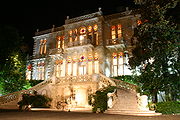
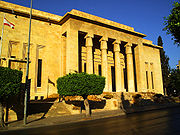 Other major museums:
Other major museums:
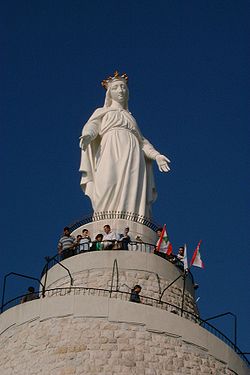
and Islam
, Lebanon has an old and rich religious background with diverse traditions. This is evident in the religious and multicultural blend that can be seen till present times and which gives a unique identity to the Lebanese society. Lebanon has been a refuge for persecuted religious groups from thousands of years, and thus adding a vast amount of religious heritage to the country in both Christian
and Islamic sanctuaries and holy places.
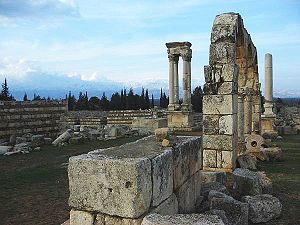 Inscribed as a world heritage site in 1984, Anjar
Inscribed as a world heritage site in 1984, Anjar
was a commercial center for Levantine trade routes. At only 1,300 years old, Anjar is one of Lebanon's newer archaeological sites. It was founded by the Umayyad
Caliph
Al-Walid ibn Abdel Malek (in the beginning of the 8th century) and takes its name from the Arabic Ain Gerrah meaning "the source of Gerrah", related to the Umayyad stronghold founded in the same era.
The city's wide avenues are lined with mosques, palaces, baths, storehouses, and residences. The city ruins cover 114,000 square meters and are surrounded by large, fortified stone walls, over two meters thick and seven meters high. The rectangular city design is based on Roman
city planning and architecture, with stonework and other features borrowed from the Byzantine
s. Two large avenues – the 20-meter-wide Cardo Maximus
, running north to south, and the Decumanus Maximus
, running east to west – divide the city into four quadrants. At the crossroads in the center of the city, four great tetrapylon
s mark the four corners of the intersection.
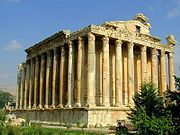 During the Phoenicia
During the Phoenicia
n era, Baalbek
was a small village where a triad of fertility gods were worshiped ( Baal-Shamash
, Anat
, and Aliyan
). Little remains of the Phoenician structures of the city which was later named Heliopolis
under the Hellenistic rule and extensively rebuilt by the Romans. After the arrival of the Romans to Phoenicia in 64 B.C., the city was transformed to a celebrated sanctuary where a Romanized triad of gods was worshiped (Jupiter
, Venus
and Mercury
) and it was overlaid during a period of two centuries by a series of colossal temples. Modern-day visitors to Baalbek can enter the site through the grand Roman propylaea
and walk through the two large colonnaded courtyards to reach the complex's great temples:
Baalbek
was inscribed as a world heritage site in 1984.
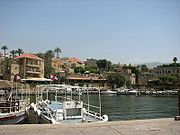
was inscribed as a world heritage site in 1984. Inhabited since the Neolithic age, it witnessed the arrival of successive civilizations, from Phoenicians and Crusaders to Ottoman Turks
. Byblos is a historical Mediterranean region dating back thousands of years and closely associated with the spread of the Phoenician alphabet
.
The main touristic sites in Byblos:

, situated in a rugged landscape north of the Western Mountain Range of Lebanon. Near the valley lies the Cedars forest, a nature reserve dedicated for the preservation of the last Cedar trees, used in antiquity for the construction of Phoenician boats and religious buildings.
List of monasteries in the Qadisha Valley:
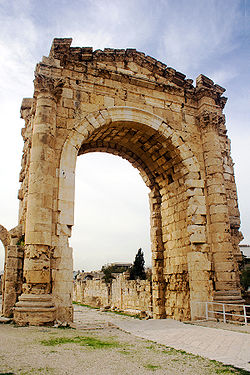 Other monasteries consist of the Monastery of Mar Girgis, with the Chapel of Mar Challita, the Monastery of Mar Yuhanna, the Monastery of Mar Abun, with the Hermitage
Other monasteries consist of the Monastery of Mar Girgis, with the Chapel of Mar Challita, the Monastery of Mar Yuhanna, the Monastery of Mar Abun, with the Hermitage
of Mar Sarkis, and the Monastery of Mart Moura, Ehden
.
and had founded several colonies in the Mediterranean such as Carthage
and Cadiz
. Many civilizations successively settled in Tyre from Phoenicians, Greeks
and Romans to Crusaders and Ottoman Turks. Today, there are still many valuable remains mainly from the Roman era.
Major archaeological sites in Tyre:
 Ecotourism
Ecotourism
in Lebanon has a rich background of natural diversity and a wide range of outdoor activities. With an original landscape consisting of mountains, forests, wildlife, beaches, snow fed rivers, caves, valleys and gorges, Lebanon is becoming more of an outdoor destination where people can visit its natural reserves and practice their ecotourism activities.

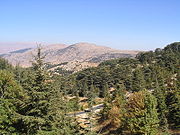 Ecotourism activities and sports:
Ecotourism activities and sports:
Natural reserves:
Major Outdoor activities:
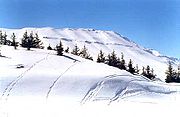 Although Lebanon is considered to be a summer destination, winter sports are becoming more in demand due to the close geographical location of the mountain peaks from the Mediterranean sea and the unique winter experience that visitors have. Lebanese winter sports include Alpine skiing
Although Lebanon is considered to be a summer destination, winter sports are becoming more in demand due to the close geographical location of the mountain peaks from the Mediterranean sea and the unique winter experience that visitors have. Lebanese winter sports include Alpine skiing
and Cross Country
in addition to paragliding
, snowmobiling, and hiking
.
The Ski resorts:
Popular Beaches and water park
s in Lebanon:
Art Galleries in Lebanon:
 The Lebanese cuisine, mostly resembling Turkish cuisine, combines the exotic ingredients of the Middle and Far East
The Lebanese cuisine, mostly resembling Turkish cuisine, combines the exotic ingredients of the Middle and Far East
with the sophistication of European cuisine
. Although the Lebanese cuisine has a recent popularity throughout the world, its history dates back to pre-biblical times. This eastern Mediterranean cuisine, which is located in a relatively small geographical area, has had a major influence on Middle Eastern cuisine and other neighboring culinary cultures. Nowadays, Lebanese cuisine is known throughout the world, especially with the recent emphasis on the health benefits of Mediterranean cuisine. The significant importance of this ancient cuisine has also inspired professional chefs and restaurateurs across the country to feature exciting Lebanese items on their menus.
, copper
and metalworking
, embroidery
, glass blowing, and gold and silver smithing. Some Lebanese villages are also known for their finely crafted church bells.
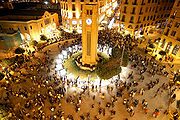
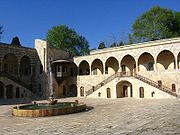 There is a wide range of festivals that take place in Lebanon, especially in the summer season where festivities including both Lebanese and international performers take place in major archaeological and historical sites, including Baalbek
There is a wide range of festivals that take place in Lebanon, especially in the summer season where festivities including both Lebanese and international performers take place in major archaeological and historical sites, including Baalbek
, Byblos
(Jbail), and Beiteddine.
Major Lebanese festivals:
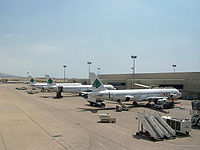 Tourism was once a very important contributor to Lebanon's economy, accounting for almost 20 percent of the GDP in the 2 decades before the start of the civil war
Tourism was once a very important contributor to Lebanon's economy, accounting for almost 20 percent of the GDP in the 2 decades before the start of the civil war
. Since the end of the war, the sector has managed to revive somewhat, but tourism has yet to return to its pre-war levels. Tourism in 1999 accounted for 9 percent of the GDP. In 2001, the tourism sector was one of the fastest growing sectors of the economy, with the number of tourists visiting Lebanon between 1996 and 2000 growing at the rate of 14 percent annually. In 2003 the tourism industry contributed 6.374 billion U.S. dollars to the Lebanese economy and in 2005 the receipts per capita reached 1,433 U.S. dollars. In 2006 the ministry of Tourism counted 373,037 admissions to the country's main ministry run touristic sites. In 2009, Lebanon hosted about two million tourists, a record number, passing the previous 1974 record of 1.4 million tourists. The number of tourists grew by 39% over the previous year, the largest increase in any country according the World Tourism Organization
. Most of the increase is due to heightened political stability and security. Lebanon was also featured by several international media outlets, including the New York Times, CNN
, and Paris Match
, as a top tourist destination at the beginning of 2009. Lebanon's annual income from tourism reached $7 billion, about 20 percent of gross domestic product, according to the Minister of Tourism. Despite the recent surge in popularity as a tourist destination, the U.S. State Department continues to "urge U.S. citizens to avoid all travel to Lebanon due to current safety and security concerns".
Lebanon
Lebanon , officially the Republic of LebanonRepublic of Lebanon is the most common term used by Lebanese government agencies. The term Lebanese Republic, a literal translation of the official Arabic and French names that is not used in today's world. Arabic is the most common language spoken among...
has been historically important to the local economy and remains to this day to be a major source of revenue for Lebanon. Before the Lebanese Civil War
Lebanese Civil War
The Lebanese Civil War was a multifaceted civil war in Lebanon. The war lasted from 1975 to 1990 and resulted in an estimated 150,000 to 230,000 civilian fatalities. Another one million people were wounded, and today approximately 350,000 people remain displaced. There was also a mass exodus of...
, Beirut
Beirut
Beirut is the capital and largest city of Lebanon, with a population ranging from 1 million to more than 2 million . Located on a peninsula at the midpoint of Lebanon's Mediterranean coastline, it serves as the country's largest and main seaport, and also forms the Beirut Metropolitan...
was widely regarded as "The Paris of the Middle East," often cited as a financial and business hub where visitors could experience the Levant
Levant
The Levant or ) is the geographic region and culture zone of the "eastern Mediterranean littoral between Anatolia and Egypt" . The Levant includes most of modern Lebanon, Syria, Jordan, Israel, the Palestinian territories, and sometimes parts of Turkey and Iraq, and corresponds roughly to the...
ine Mediterranean
Mediterranean Sea
The Mediterranean Sea is a sea connected to the Atlantic Ocean surrounded by the Mediterranean region and almost completely enclosed by land: on the north by Anatolia and Europe, on the south by North Africa, and on the east by the Levant...
culture.
Lebanon's diverse atmosphere and ancient history make it an important destination which is slowly rebuilding itself after continued turmoil. Lebanon offers plenty: from ancient Roman
Ancient Rome
Ancient Rome was a thriving civilization that grew on the Italian Peninsula as early as the 8th century BC. Located along the Mediterranean Sea and centered on the city of Rome, it expanded to one of the largest empires in the ancient world....
ruins, to well preserved castles, limestone caves, historic Churches and Mosques, beautiful beaches nestled in the Mediterranean Sea, world renown Lebanese cuisine
Lebanese cuisine
Lebanese cuisine includes an abundance of starches, fruits, vegetables, fresh fish and seafood; animal fats are consumed sparingly. Poultry is eaten more often than red meat, and when red meat is eaten it is usually lamb on the coast and goat meat in the mountain regions...
, nonstop nightlife and discothèques, to mountainous ski resorts.
Significant private investment is currently being made in the modernization and expansion of this sector and international hotel companies have returned to Lebanon. Casino du Liban
Casino du Liban
Casino du Liban is a casino located in Maameltein, Jounieh in Lebanon and is 22 km north of Beirut.With an area of about 35,000 square meters, the casino has around 400 slot machines and 60 gaming tables. It has a showroom, night club, theater, banquet facility and five restaurants. The casino was...
, which historically constituted a major tourist destination, reopened in 1996. Lebanon is the only country in the Arab
Arab
Arab people, also known as Arabs , are a panethnicity primarily living in the Arab world, which is located in Western Asia and North Africa. They are identified as such on one or more of genealogical, linguistic, or cultural grounds, with tribal affiliations, and intra-tribal relationships playing...
world that offers skiing and related winter sports activities. The largest ski resort in the country has been expanded and modernized. The Government believes that, because of the return of peace and stability to the country and with the development of the necessary infrastructure, tourism will again contribute significantly to Lebanon's economy. Lebanon's tourism industry also relies on the large number of Lebanese living abroad, who return regularly to the country during the summer season.
Cultural tourism
Lebanon is considered to be a mosaic of cultural diversity, where the Eastern and Western worlds meet in all their unique and historical richness. From Stone AgeStone Age
The Stone Age is a broad prehistoric period, lasting about 2.5 million years , during which humans and their predecessor species in the genus Homo, as well as the earlier partly contemporary genera Australopithecus and Paranthropus, widely used exclusively stone as their hard material in the...
settlements to Phoenicia
Phoenicia
Phoenicia , was an ancient civilization in Canaan which covered most of the western, coastal part of the Fertile Crescent. Several major Phoenician cities were built on the coastline of the Mediterranean. It was an enterprising maritime trading culture that spread across the Mediterranean from 1550...
n city-states, from Roman
Ancient Rome
Ancient Rome was a thriving civilization that grew on the Italian Peninsula as early as the 8th century BC. Located along the Mediterranean Sea and centered on the city of Rome, it expanded to one of the largest empires in the ancient world....
temples to rock-cut hermitages
Hermitage (religious retreat)
Although today's meaning is usually a place where a hermit lives in seclusion from the world, hermitage was more commonly used to mean a settlement where a person or a group of people lived religiously, in seclusion.-Western Christian Tradition:...
, from Crusader
Crusades
The Crusades were a series of religious wars, blessed by the Pope and the Catholic Church with the main goal of restoring Christian access to the holy places in and near Jerusalem...
Castles to Mamluk
Mamluk
A Mamluk was a soldier of slave origin, who were predominantly Cumans/Kipchaks The "mamluk phenomenon", as David Ayalon dubbed the creation of the specific warrior...
mosques and Ottoman
Ottoman Empire
The Ottoman EmpireIt was usually referred to as the "Ottoman Empire", the "Turkish Empire", the "Ottoman Caliphate" or more commonly "Turkey" by its contemporaries...
hammam
Hammam
A Turkish bath is the Turkish variant of a steam bath, sauna or Russian Bath, distinguished by a focus on water, as distinct from ambient steam....
s, the country's historical and archaeological sites are a true encyclopedia of ancient and modern world history.
Lebanon has a long standing history of cultural tourism
Cultural tourism
Cultural tourism is the subset of tourism concerned with a country or region's culture, specifically the lifestyle of the people in those geographical areas, the history of those peoples, their art, architecture, religion, and other elements that helped shape their way of life...
. Interest in the Lebanese
Lebanese people
The Lebanese people are a nation and ethnic group of Levantine people originating in what is today the country of Lebanon, including those who had inhabited Mount Lebanon prior to the creation of the modern Lebanese state....
Levant
Levant
The Levant or ) is the geographic region and culture zone of the "eastern Mediterranean littoral between Anatolia and Egypt" . The Levant includes most of modern Lebanon, Syria, Jordan, Israel, the Palestinian territories, and sometimes parts of Turkey and Iraq, and corresponds roughly to the...
ine culture was stirred following the visits of many European orientalists, scholars and poets particularly Alphonse de Lamartine
Alphonse de Lamartine
Alphonse Marie Louis de Prat de Lamartine was a French writer, poet and politician who was instrumental in the foundation of the Second Republic.-Career:...
, Ernest Renan
Ernest Renan
Ernest Renan was a French expert of Middle East ancient languages and civilizations, philosopher and writer, devoted to his native province of Brittany...
and Victor Guérin
Victor Guérin
Victor Guérin was a French intellectual, explorer and amateur archaeologist. He published books describing the geography, archeology and history of the areas he explored, which included Greece, Asia Minor, North Africa, Syria and Palestine.-Biography:From 1840, Guerin was a professor of rhetoric...
.
Lebanon's cultural tourism
Cultural tourism
Cultural tourism is the subset of tourism concerned with a country or region's culture, specifically the lifestyle of the people in those geographical areas, the history of those peoples, their art, architecture, religion, and other elements that helped shape their way of life...
focal points are historic monuments, archaeological sites, cultural venues, traditional art, rural customs, religious festivals and pilgrimage.
Archaeotourism
Archaeology in Lebanon has an old and productive history, many archaeological sites have been excavated and some restored, yet many remain buried under inhabited areas within the cities.Museums

- Beirut National Museum, established in 1937 the museum exhibits about 100,000 objects, most of which are antiquitiesAntiquitiesAntiquities, nearly always used in the plural in this sense, is a term for objects from Antiquity, especially the civilizations of the Mediterranean: the Classical antiquity of Greece and Rome, Ancient Egypt and the other Ancient Near Eastern cultures...
and medieval findings with approximately 1300 artifacts ranging in date from prehistoric times to the medieval MamlukMamlukA Mamluk was a soldier of slave origin, who were predominantly Cumans/Kipchaks The "mamluk phenomenon", as David Ayalon dubbed the creation of the specific warrior...
period. - Gibran Museum, originally a monastery in BsharriBsharriBsharri , is a Lebanese town at about 1,450 m of altitude, near the Kadisha Valley. It is located at , in the Bsharri District of the North Governorate. Bsharri is the town of the only remaining Original Cedars of Lebanon...
, it was transformed into a museum by the Gibran National Committee in honoring of the Lebanese American philosopher, writer, poet, painter and theologian Gibran Khalil Gibran. The museum exhibits Gibran's notebooks, furniture, personal library, and paintings. - AUBAmerican University of BeirutThe American University of Beirut is a private, independent university in Beirut, Lebanon. It was founded as the Syrian Protestant College by American missionaries in 1866...
Museum, the third oldest museum in the near eastNear EastThe Near East is a geographical term that covers different countries for geographers, archeologists, and historians, on the one hand, and for political scientists, economists, and journalists, on the other...
, the AUB Museum exhibits LevantLevantThe Levant or ) is the geographic region and culture zone of the "eastern Mediterranean littoral between Anatolia and Egypt" . The Levant includes most of modern Lebanon, Syria, Jordan, Israel, the Palestinian territories, and sometimes parts of Turkey and Iraq, and corresponds roughly to the...
ine artifacts from the Early Stone AgeStone AgeThe Stone Age is a broad prehistoric period, lasting about 2.5 million years , during which humans and their predecessor species in the genus Homo, as well as the earlier partly contemporary genera Australopithecus and Paranthropus, widely used exclusively stone as their hard material in the...
to the Islamic period.

- Ameen Rihani Museum
- M. Farroukh Museum
- Museum and Library of the Catholicosate of CiliciaCiliciaIn antiquity, Cilicia was the south coastal region of Asia Minor, south of the central Anatolian plateau. It existed as a political entity from Hittite times into the Byzantine empire...
- BaalbekBaalbekBaalbek is a town in the Beqaa Valley of Lebanon, altitude , situated east of the Litani River. It is famous for its exquisitely detailed yet monumentally scaled temple ruins of the Roman period, when Baalbek, then known as Heliopolis, was one of the largest sanctuaries in the Empire...
Museum - Dahesh MuseumDahesh MuseumThe Dahesh Museum of Art is the only museum in the United States devoted to the collection and exhibition of European academic art of the 19th and 20th century. The collection originated with Lebanese writer, humanist, and philosopher Saleem Moussa Ashi , whose pen name was Dr. Dahesh. The core of...
of Art - Lebanese Heritage MuseumLebanese Heritage MuseumThe Lebanese Heritage Museum is a museum in Jounieh, Lebanon. It contains objects related to the history and culture of Lebanon from the Phoenician era to modern times.-External links:*...
- Expo Hakel Lebanon
- Robert Mouawad Private Museum Lebanon
- Byblos Fossil MuseumByblos Fossil MuseumThe Byblos Fossil Museum is a museum in Byblos, Lebanon. This museum contains fossil collections of sharks, eels, shrimps, squids, rays, coelacanthes and flying fish. It was opened in 1991 and is located in the old souk of Byblos...
- Sursock MuseumSursock MuseumSursock Museum, which is officially known as Nicolas Sursock Museum, is a modern art museum in Beirut, Lebanon. It is located in the historic street known as Rue Sursock in the Achrafieh district of Beirut. The street is home to other mansions that were built in the 18th century by Beirut's most...
- Byblos Wax MuseumByblos Wax MuseumThe Byblos Wax Museum is a wax museum in Byblos, Lebanon. This museum displays wax statues and life scenes from the Phoenician era to the modern times.- Some of the wax figures :*Cadmus*Europa*Adonis*Ashtarout*Ahiram*Fakhreddine II*Bashir Shihab II...
- Memory of Time Museum
- Sidon Soap MuseumSidon Soap MuseumThe Sidon Soap Museum is a museum in Sidon, Lebanon. It traces the history of soap making in the region, its development and manufacturing techniques. Visitors can see a demonstration of how traditional olive oil soaps are made and learn about the history of the "hammam" traditions...
- Museum of Lebanese PrehistoryMuseum of Lebanese PrehistoryThe Museum of Lebanese Prehistory is a museum of prehistory and archaeology in Beirut, Lebanon.-History:...

Religious Tourism
Located in the heart of the two major world religions, ChristianityChristianity
Christianity is a monotheistic religion based on the life and teachings of Jesus as presented in canonical gospels and other New Testament writings...
and Islam
Islam
Islam . The most common are and . : Arabic pronunciation varies regionally. The first vowel ranges from ~~. The second vowel ranges from ~~~...
, Lebanon has an old and rich religious background with diverse traditions. This is evident in the religious and multicultural blend that can be seen till present times and which gives a unique identity to the Lebanese society. Lebanon has been a refuge for persecuted religious groups from thousands of years, and thus adding a vast amount of religious heritage to the country in both Christian
Christian
A Christian is a person who adheres to Christianity, an Abrahamic, monotheistic religion based on the life and teachings of Jesus of Nazareth as recorded in the Canonical gospels and the letters of the New Testament...
and Islamic sanctuaries and holy places.
Anjar

Anjar, Lebanon
Anjar , also known as Haoush Mousa , is a town of Lebanon located in the Bekaa Valley. The population is 2,400, consisting almost entirely of Armenians. The total area is about twenty square kilometers...
was a commercial center for Levantine trade routes. At only 1,300 years old, Anjar is one of Lebanon's newer archaeological sites. It was founded by the Umayyad
Umayyad
The Umayyad Caliphate was the second of the four major Arab caliphates established after the death of Muhammad. It was ruled by the Umayyad dynasty, whose name derives from Umayya ibn Abd Shams, the great-grandfather of the first Umayyad caliph. Although the Umayyad family originally came from the...
Caliph
Caliph
The Caliph is the head of state in a Caliphate, and the title for the ruler of the Islamic Ummah, an Islamic community ruled by the Shari'ah. It is a transcribed version of the Arabic word which means "successor" or "representative"...
Al-Walid ibn Abdel Malek (in the beginning of the 8th century) and takes its name from the Arabic Ain Gerrah meaning "the source of Gerrah", related to the Umayyad stronghold founded in the same era.
The city's wide avenues are lined with mosques, palaces, baths, storehouses, and residences. The city ruins cover 114,000 square meters and are surrounded by large, fortified stone walls, over two meters thick and seven meters high. The rectangular city design is based on Roman
Ancient Rome
Ancient Rome was a thriving civilization that grew on the Italian Peninsula as early as the 8th century BC. Located along the Mediterranean Sea and centered on the city of Rome, it expanded to one of the largest empires in the ancient world....
city planning and architecture, with stonework and other features borrowed from the Byzantine
Byzantine
Byzantine usually refers to the Roman Empire during the Middle Ages.Byzantine may also refer to:* A citizen of the Byzantine Empire, or native Greek during the Middle Ages...
s. Two large avenues – the 20-meter-wide Cardo Maximus
Cardo
The cardo was a north-south oriented street in Roman cities, military camps, and coloniae. The cardo, an integral component of city planning, was lined with shops and vendors, and served as a hub of economic life. The main cardo was called cardo maximus.Most Roman cities also had a Decumanus...
, running north to south, and the Decumanus Maximus
Decumanus Maximus
In Roman city planning, a decumanus was an east-west-oriented road in a Roman city, castra , or colonia. The main decumanus was the Decumanus Maximus, which normally connected the Porta Praetoria to the Porta Decumana .This name comes from the fact that the via decumana or decimana In Roman city...
, running east to west – divide the city into four quadrants. At the crossroads in the center of the city, four great tetrapylon
Tetrapylon
The South Tetrapylon -- which is greek for "four gates"-- is the intersection of Jerash's Cardo with the first cross street in the ancient ruins of Jerash in Jordan dated to the Roman period at the end of the 2nd century AD. Four niched pilasters formed the base of a former central monument....
s mark the four corners of the intersection.
Baalbeck

Phoenicia
Phoenicia , was an ancient civilization in Canaan which covered most of the western, coastal part of the Fertile Crescent. Several major Phoenician cities were built on the coastline of the Mediterranean. It was an enterprising maritime trading culture that spread across the Mediterranean from 1550...
n era, Baalbek
Baalbek
Baalbek is a town in the Beqaa Valley of Lebanon, altitude , situated east of the Litani River. It is famous for its exquisitely detailed yet monumentally scaled temple ruins of the Roman period, when Baalbek, then known as Heliopolis, was one of the largest sanctuaries in the Empire...
was a small village where a triad of fertility gods were worshiped ( Baal-Shamash
Baal
Baʿal is a Northwest Semitic title and honorific meaning "master" or "lord" that is used for various gods who were patrons of cities in the Levant and Asia Minor, cognate to Akkadian Bēlu...
, Anat
Anat
Anat, also ‘Anat is a major northwest Semitic goddess.-‘Anat in Ugarit:In the Ugaritic Ba‘al/Hadad cycle ‘Anat is a violent war-goddess, a virgin in Ugarit though the sister and lover of the great Ba‘al known as Hadad elsewhere. Ba‘al is usually called the son of Dagon and sometimes the son of El....
, and Aliyan
Hadad
Haddad was a northwest Semitic storm and rain god, cognate in name and origin with the Akkadian god Adad. Hadad was often called simply Ba‘al , but this title was also used for other gods. The bull was the symbolic animal of Hadad. He appeared as a bearded deity, often shown as holding a club and...
). Little remains of the Phoenician structures of the city which was later named Heliopolis
Helios
Helios was the personification of the Sun in Greek mythology. Homer often calls him simply Titan or Hyperion, while Hesiod and the Homeric Hymn separate him as a son of the Titans Hyperion and Theia or Euryphaessa and brother of the goddesses Selene, the moon, and Eos, the dawn...
under the Hellenistic rule and extensively rebuilt by the Romans. After the arrival of the Romans to Phoenicia in 64 B.C., the city was transformed to a celebrated sanctuary where a Romanized triad of gods was worshiped (Jupiter
Jupiter (mythology)
In ancient Roman religion and myth, Jupiter or Jove is the king of the gods, and the god of the sky and thunder. He is the equivalent of Zeus in the Greek pantheon....
, Venus
Venus (mythology)
Venus is a Roman goddess principally associated with love, beauty, sex,sexual seduction and fertility, who played a key role in many Roman religious festivals and myths...
and Mercury
Mercury (mythology)
Mercury was a messenger who wore winged sandals, and a god of trade, the son of Maia Maiestas and Jupiter in Roman mythology. His name is related to the Latin word merx , mercari , and merces...
) and it was overlaid during a period of two centuries by a series of colossal temples. Modern-day visitors to Baalbek can enter the site through the grand Roman propylaea
Propylaea
A Propylaea, Propylea or Propylaia is any monumental gateway based on the original Propylaea that serves as the entrance to the Acropolis in Athens...
and walk through the two large colonnaded courtyards to reach the complex's great temples:
- The Temple of JupiterJupiter (mythology)In ancient Roman religion and myth, Jupiter or Jove is the king of the gods, and the god of the sky and thunder. He is the equivalent of Zeus in the Greek pantheon....
was the largest Roman temple ever constructed. Today, just six of the original 54 Corinthian columns remain standing. Each column is 22 meters (66 ft) high and 2 meters (7.5 ft) in diameter, hinting at the temple's enormous size in the time of the Roman Empire .
- The Temple of BacchusDionysusDionysus was the god of the grape harvest, winemaking and wine, of ritual madness and ecstasy in Greek mythology. His name in Linear B tablets shows he was worshipped from c. 1500—1100 BC by Mycenean Greeks: other traces of Dionysian-type cult have been found in ancient Minoan Crete...
is the best-preserved Roman temple in the Middle East. Although smaller than the Temple of Jupiter, the Temple of Bacchus is still larger than the ParthenonParthenonThe Parthenon is a temple on the Athenian Acropolis, Greece, dedicated to the Greek goddess Athena, whom the people of Athens considered their virgin patron. Its construction began in 447 BC when the Athenian Empire was at the height of its power. It was completed in 438 BC, although...
in AthensAthensAthens , is the capital and largest city of Greece. Athens dominates the Attica region and is one of the world's oldest cities, as its recorded history spans around 3,400 years. Classical Athens was a powerful city-state...
. The dedication and purpose of this temple, and its relationship to the rest of the temple complex, remain a mystery.
- The Temple of VenusVenus (mythology)Venus is a Roman goddess principally associated with love, beauty, sex,sexual seduction and fertility, who played a key role in many Roman religious festivals and myths...
is a smaller, domed structure set apart to the southeast of the complex. During the Byzantine period, the temple was converted into a church honoring Saint BarbaraSaint BarbaraSaint Barbara, , Feast Day December 4, known in the Eastern Orthodox Church as the Great Martyr Barbara, was an early Christian saint and martyr....
.
- Only part of the staircase from the Temple of MercuryMercury (mythology)Mercury was a messenger who wore winged sandals, and a god of trade, the son of Maia Maiestas and Jupiter in Roman mythology. His name is related to the Latin word merx , mercari , and merces...
can still be seen on Sheikh Abdallah hill, a short distance away from the main temple site.
Baalbek
Baalbek
Baalbek is a town in the Beqaa Valley of Lebanon, altitude , situated east of the Litani River. It is famous for its exquisitely detailed yet monumentally scaled temple ruins of the Roman period, when Baalbek, then known as Heliopolis, was one of the largest sanctuaries in the Empire...
was inscribed as a world heritage site in 1984.

Byblos
ByblosByblos
Byblos is the Greek name of the Phoenician city Gebal . It is a Mediterranean city in the Mount Lebanon Governorate of present-day Lebanon under the current Arabic name of Jubayl and was also referred to as Gibelet during the Crusades...
was inscribed as a world heritage site in 1984. Inhabited since the Neolithic age, it witnessed the arrival of successive civilizations, from Phoenicians and Crusaders to Ottoman Turks
Ottoman Turks
The Ottoman Turks were the Turkish-speaking population of the Ottoman Empire who formed the base of the state's military and ruling classes. Reliable information about the early history of Ottoman Turks is scarce, but they take their Turkish name, Osmanlı , from the house of Osman I The Ottoman...
. Byblos is a historical Mediterranean region dating back thousands of years and closely associated with the spread of the Phoenician alphabet
Phoenician alphabet
The Phoenician alphabet, called by convention the Proto-Canaanite alphabet for inscriptions older than around 1050 BC, was a non-pictographic consonantal alphabet, or abjad. It was used for the writing of Phoenician, a Northern Semitic language, used by the civilization of Phoenicia...
.
The main touristic sites in Byblos:
- Ancient Phoenician Temples, that include the Great Temple or L-Shaped temple, Temple of Baalat Gebal, and the Temple of the Obelisks.
- Byblos Castle, a 12th century Crusader castle located near the port.
- Byblos Mosque, considered to be the oldest mosque in the world.
- Medieval City Wall
- Byblos Wax Museum
- St John the Baptist Church, a Crusader church built in 1150.
- Byblos Fossil Museum
- Historic Quarter and SoukSoukA souq is a commercial quarter in an Arab, Berber, and increasingly European city. The term is often used to designate the market in any Arabized or Muslim city, but in modern times it appears in Western cities too...
s, near the entrance of the archaeological site.

Qadisha Valley and Cedars Forest
Inscribed as a world heritage site in 1998, the Qadisha Valley and Cedars Forest (also known as the Forest of the Cedars of God) are considered to be of significant importance. The Qadisha valley was a settlement of early Christian monasticismChristian monasticism
Christian monasticism is a practice which began to develop early in the history of the Christian Church, modeled upon scriptural examples and ideals, including those in the Old Testament, but not mandated as an institution in the scriptures. It has come to be regulated by religious rules Christian...
, situated in a rugged landscape north of the Western Mountain Range of Lebanon. Near the valley lies the Cedars forest, a nature reserve dedicated for the preservation of the last Cedar trees, used in antiquity for the construction of Phoenician boats and religious buildings.
List of monasteries in the Qadisha Valley:
- The Qannubin Monastery, the oldest of the Maronite monasteries in the valley.
- The Monastery of St Anthony of QozhayaQozhayaQozhaya is located in the Zgharta District in the North Governorate of Lebanon. It belongs to the Lebanese Maronite Order, known as Baladites.-Monastery of Saint Anthony of Qozhaya:...
, traditionally founded in the 4th century by St Hilarion. - The Monastery of Our Lady of HawqaHawqaHawqa is a village located in the Zgharta District in the North Governorate of Lebanon. It is situated in the valley of Qozhaya, the northern branch of the Valley of Qadisha....
, founded in the late 13th century by villagers from Hawqa. - The Monastery of Mar Sarkis, EhdenMar Sarkis, EhdenThe Monastery of Mar Sarkis, Ehden is a monastery located in the Zgharta District in the North Governorate of Lebanon. It is situated in the Qozhaya valley, the northern branch of the valley of Qadisha, to the east of Ehden.It overlooks Ehden, Kfarsghab, Bane and Hadath El Jebbeh...
, successively built in the 8th century, 1198 and 1690. - The Monastery of Mar Lishaa, comprising a Maronite solitary order and a Barefoot Carmelite order.

Hermitage (religious retreat)
Although today's meaning is usually a place where a hermit lives in seclusion from the world, hermitage was more commonly used to mean a settlement where a person or a group of people lived religiously, in seclusion.-Western Christian Tradition:...
of Mar Sarkis, and the Monastery of Mart Moura, Ehden
Ehden
Ehden is a mountainous town situated in the heart of the northern mountains of Lebanon and on the southwestern slopes of Mount Makmal and Kornet el Sawda, the highest peak in Lebanon...
.
Tyre
Tyre was inscribed as a world heritage site in 1984. It was the birthplace of the purple dye known as Tyrian purpleTyrian purple
Tyrian purple , also known as royal purple, imperial purple or imperial dye, is a purple-red natural dye, which is extracted from sea snails, and which was possibly first produced by the ancient Phoenicians...
and had founded several colonies in the Mediterranean such as Carthage
Carthage
Carthage , implying it was a 'new Tyre') is a major urban centre that has existed for nearly 3,000 years on the Gulf of Tunis, developing from a Phoenician colony of the 1st millennium BC...
and Cadiz
Cádiz
Cadiz is a city and port in southwestern Spain. It is the capital of the homonymous province, one of eight which make up the autonomous community of Andalusia....
. Many civilizations successively settled in Tyre from Phoenicians, Greeks
Greeks
The Greeks, also known as the Hellenes , are a nation and ethnic group native to Greece, Cyprus and neighboring regions. They also form a significant diaspora, with Greek communities established around the world....
and Romans to Crusaders and Ottoman Turks. Today, there are still many valuable remains mainly from the Roman era.
Major archaeological sites in Tyre:
- Al-Bass site, having a three bay monumental arch, an extensive necropolisNecropolisA necropolis is a large cemetery or burial ground, usually including structural tombs. The word comes from the Greek νεκρόπολις - nekropolis, literally meaning "city of the dead"...
and a large hippodromeHippodromeA hippodrome was a Greek stadium for horse racing and chariot racing. The name is derived from the Greek words "hippos and "dromos"...
(all dating from the 2nd century AD to the 6th century AD). - City site, in the old Phoenician island city, it consists of colonnadeColonnadeIn classical architecture, a colonnade denotes a long sequence of columns joined by their entablature, often free-standing, or part of a building....
s, public baths, mosaics, streets, a vast district of civic buildings and a rectangular arena.
Ecotourism

Ecotourism
Ecotourism is a form of tourism visiting fragile, pristine, and usually protected areas, intended as a low impact and often small scale alternative to standard commercial tourism...
in Lebanon has a rich background of natural diversity and a wide range of outdoor activities. With an original landscape consisting of mountains, forests, wildlife, beaches, snow fed rivers, caves, valleys and gorges, Lebanon is becoming more of an outdoor destination where people can visit its natural reserves and practice their ecotourism activities.


- ATV (All-terrain vehicleAll-terrain vehicleAn all-terrain vehicle , also known as a quad, quad bike, three wheeler, or four wheeler, is defined by the American National Standards Institute as a vehicle that travels on low pressure tires, with a seat that is straddled by the operator, along with handlebars for steering control...
) - RaftingRaftingRafting or white water rafting is a challenging recreational outdoor activity using an inflatable raft to navigate a river or other bodies of water. This is usually done on white water or different degrees of rough water, in order to thrill and excite the raft passengers. The development of this...
- HikingHikingHiking is an outdoor activity which consists of walking in natural environments, often in mountainous or other scenic terrain. People often hike on hiking trails. It is such a popular activity that there are numerous hiking organizations worldwide. The health benefits of different types of hiking...
- CavingCavingCaving—also occasionally known as spelunking in the United States and potholing in the United Kingdom—is the recreational pastime of exploring wild cave systems...
- Dirt biking
- Via FerrataVia ferrataA via ferrata or klettersteig is a mountain route which is equipped with fixed cables, stemples, ladders, and bridges. The use of these allows otherwise isolated routes to be joined to create longer routes which are accessible to people with a wide range of climbing abilities...
- Rappelling
- Horse riding
- SnowboardingSnowboardingSnowboarding is a sport that involves descending a slope that is covered with snow on a snowboard attached to a rider's feet using a special boot set onto mounted binding. The development of snowboarding was inspired by skateboarding, sledding, surfing and skiing. It was developed in the U.S.A...
- Mountain bikingMountain bikingMountain biking is a sport which consists of riding bicycles off-road, often over rough terrain, using specially adapted mountain bikes. Mountain bikes share similarities with other bikes, but incorporate features designed to enhance durability and performance in rough terrain.Mountain biking can...
- Mountain climbing
Natural reserves:
- Al Shouf Cedar Nature ReserveAl Shouf Cedar Nature ReserveAl Shouf Cedar Nature Reserve is a nature reserve in the Chouf District of Lebanon. It is located on the slopes of Barouk mountain and has an area of 550 km², nearly 5.3% of the Lebanese territory....
- Horsh EhdenHorsh EhdenHorsh Ehden is a Nature Reserve located in north Lebanon, it contains a particularly diverse and beautiful remnant forest of the Cedar of Lebanon, making the reserve a very important part of the country’s cultural and natural heritage...
Nature Reserve - La Reserve Afqa
- Palm Islands Nature Reserve
- Tannourine Nature Reserve
- Tyre Beach Nature Reserve
- Yammouneh Nature Reserve
Lebanese outdoors
Lebanon's nature and geography, which are unique to the Middle East region, allow the practice of outdoor activities (mainly concentrated in the summer season). Nowadays, these activities are gaining more interest from nature lovers and becoming well equipped with the specific requirements and facilities.Major Outdoor activities:
- CampingCampingCamping is an outdoor recreational activity. The participants leave urban areas, their home region, or civilization and enjoy nature while spending one or several nights outdoors, usually at a campsite. Camping may involve the use of a tent, caravan, motorhome, cabin, a primitive structure, or no...
, a popular outdoor activity concentrated between the months of May and September. - CavingCavingCaving—also occasionally known as spelunking in the United States and potholing in the United Kingdom—is the recreational pastime of exploring wild cave systems...
, an important Lebanese natural heritage (3 of the major caves are Afqa Grotto, Roueiss cave and Ain El Libne). - CyclingCyclingCycling, also called bicycling or biking, is the use of bicycles for transport, recreation, or for sport. Persons engaged in cycling are cyclists or bicyclists...
, a notable activity of recent interest. - HikingHikingHiking is an outdoor activity which consists of walking in natural environments, often in mountainous or other scenic terrain. People often hike on hiking trails. It is such a popular activity that there are numerous hiking organizations worldwide. The health benefits of different types of hiking...
, an activity with a high number of trails (some of the hiking locations are Al Shouf Cedar Nature ReserveAl Shouf Cedar Nature ReserveAl Shouf Cedar Nature Reserve is a nature reserve in the Chouf District of Lebanon. It is located on the slopes of Barouk mountain and has an area of 550 km², nearly 5.3% of the Lebanese territory....
, Ramlieh, Qammouah, the Horsh EhdenHorsh EhdenHorsh Ehden is a Nature Reserve located in north Lebanon, it contains a particularly diverse and beautiful remnant forest of the Cedar of Lebanon, making the reserve a very important part of the country’s cultural and natural heritage...
reserve and Nahr Ibrahim). - ParaglidingParaglidingParagliding is the recreational and competitive adventure sport of flying paragliders: lightweight, free-flying, foot-launched glider aircraft with no rigid primary structure...
, one of the best glide ports in the Middle East (the paragliding locations are The CedarsThe CedarsThe Cedars may refer to:Places in the United States* The Cedars, California, an unincorporated community* The Cedars , listed on the NRHP in Georgia* The Cedars , listed on the NRHP in Georgia...
, Lassa, MiziaraMiziaraMiziara is a village located in the Zgharta District in the North Governorate of Lebanon. The village is home to the Marian shrine, Our Lady of Miziara, Mother of Mercies....
, HarissaHarissa, LebanonHarissa is a mountain village in Lebanon. The village, which is located 650 meters above sea level, is home to an important Lebanese pilgrimage site, Our Lady of Lebanon. The village is located 20 km north of Beirut Beirut, and it accessible from the coastal city of Jounieh either by road...
, BaroukBaroukBarouk is a village in the Chouf District of Lebanon . Historically, the village is known for being the "land of good", because of its fountain . The poet Rachid Nakhleh, the writer of the national hymn , was born in Barouk...
and Faraya). - RaftingRaftingRafting or white water rafting is a challenging recreational outdoor activity using an inflatable raft to navigate a river or other bodies of water. This is usually done on white water or different degrees of rough water, in order to thrill and excite the raft passengers. The development of this...
, a recently introduced sport practiced in locations like the Assi, the Litani and the Awali rivers.
Winter Sports

Alpine skiing
Alpine skiing is the sport of sliding down snow-covered hills on skis with fixed-heel bindings. Alpine skiing can be contrasted with skiing using free-heel bindings: Ski mountaineering and nordic skiing – such as cross-country; ski jumping; and Telemark. In competitive alpine skiing races four...
and Cross Country
Cross-country skiing
Cross-country skiing is a winter sport in which participants propel themselves across snow-covered terrain using skis and poles...
in addition to paragliding
Paragliding
Paragliding is the recreational and competitive adventure sport of flying paragliders: lightweight, free-flying, foot-launched glider aircraft with no rigid primary structure...
, snowmobiling, and hiking
Hiking
Hiking is an outdoor activity which consists of walking in natural environments, often in mountainous or other scenic terrain. People often hike on hiking trails. It is such a popular activity that there are numerous hiking organizations worldwide. The health benefits of different types of hiking...
.
The Ski resorts:
- The Cedars, 1850–3087 m above sea level and 120 km from Beirut.
- Laqlouq, 1750-2200m above sea level and 60 km from Beirut.
- Faqra, 1800–2400 m above sea level and 45 km from Beirut.
- Faraya-Mzaar, 1850–2500 m above sea level and 45 km from Beirut.
- Qanat Bakiche, 1900 m above sea level and 60 km from Beirut.
- Zaarour, 1700–2000 m above sea level and 40 km from Beirut.
Leisure
Lebanon has a 200 km of seashore with about 300 days of sunshine a year, making it a favorable destination for leisure and activities that expand in different parts of the country.Popular Beaches and water park
Water park
A waterpark is an amusement park that features waterplay areas, such as water slides, splash pads, spraygrounds , lazy rivers, or other recreational bathing, swimming, and barefooting environments...
s in Lebanon:
- Oceana beach resort
- Edde Sands
- Laguava Resort
- Cyan
- Janna sur mer
- Green Beach
- Riviera Beach Club
- Bamboo bay
- Waves Aquapark
- Watergate Aquapark
Art Galleries in Lebanon:
- Zamaan Gallery, includes a collection of more than 1700 paintings by Lebanese and Middle Eastern artists (www.zamaangallery.com)
Lebanese cuisine

Far East
The Far East is an English term mostly describing East Asia and Southeast Asia, with South Asia sometimes also included for economic and cultural reasons.The term came into use in European geopolitical discourse in the 19th century,...
with the sophistication of European cuisine
European cuisine
European cuisine, or alternatively Western cuisine, is a generalised term collectively referring to the cuisines of Europe and other Western countries...
. Although the Lebanese cuisine has a recent popularity throughout the world, its history dates back to pre-biblical times. This eastern Mediterranean cuisine, which is located in a relatively small geographical area, has had a major influence on Middle Eastern cuisine and other neighboring culinary cultures. Nowadays, Lebanese cuisine is known throughout the world, especially with the recent emphasis on the health benefits of Mediterranean cuisine. The significant importance of this ancient cuisine has also inspired professional chefs and restaurateurs across the country to feature exciting Lebanese items on their menus.
Lebanese crafts
Lebanese crafts have a sense of style and beauty that attract many tourists interested in these unique handcrafted items which are considered as a significant souvenir of the tour. The production method of Lebanese crafts are mainly concentrated in small villages where the old skills are handed from generation to generation, produced from local raw materials and carefully made with a sophisticated aesthetic and skill. Different regions of the country specialize in various handicrafts such as basketry, carpet weaving, ceramics and potteryPottery
Pottery is the material from which the potteryware is made, of which major types include earthenware, stoneware and porcelain. The place where such wares are made is also called a pottery . Pottery also refers to the art or craft of the potter or the manufacture of pottery...
, copper
Copper
Copper is a chemical element with the symbol Cu and atomic number 29. It is a ductile metal with very high thermal and electrical conductivity. Pure copper is soft and malleable; an exposed surface has a reddish-orange tarnish...
and metalworking
Metalworking
Metalworking is the process of working with metals to create individual parts, assemblies, or large scale structures. The term covers a wide range of work from large ships and bridges to precise engine parts and delicate jewelry. It therefore includes a correspondingly wide range of skills,...
, embroidery
Embroidery
Embroidery is the art or handicraft of decorating fabric or other materials with needle and thread or yarn. Embroidery may also incorporate other materials such as metal strips, pearls, beads, quills, and sequins....
, glass blowing, and gold and silver smithing. Some Lebanese villages are also known for their finely crafted church bells.
Popular tourist destinations in Lebanon

- SidonSidonSidon or Saïda is the third-largest city in Lebanon. It is located in the South Governorate of Lebanon, on the Mediterranean coast, about 40 km north of Tyre and 40 km south of the capital Beirut. In Genesis, Sidon is the son of Canaan the grandson of Noah...
a 6,000 year old city on the southern coast of LebanonLebanonLebanon , officially the Republic of LebanonRepublic of Lebanon is the most common term used by Lebanese government agencies. The term Lebanese Republic, a literal translation of the official Arabic and French names that is not used in today's world. Arabic is the most common language spoken among...
. This city is an up-and-coming tourist destination boasting several attractions like the Sidon Soap MuseumSidon Soap MuseumThe Sidon Soap Museum is a museum in Sidon, Lebanon. It traces the history of soap making in the region, its development and manufacturing techniques. Visitors can see a demonstration of how traditional olive oil soaps are made and learn about the history of the "hammam" traditions...
, Sidon Sea CastleSidon Sea CastleSidon Sea Castle is a castle in Sidon, Lebanon. It was built by the Crusaders in 1228 on a small island connected to the mainland by a causeway. A climb to the top leads to the roof where there is a good view of the port and the old part of the city.Today the castle consists primarily of two...
, Old City, Our Lady of MantaraOur Lady of MantaraOur Lady of Mantara, also known in English as Our Lady of Awaiting, is a holy Christian site and a Marian shrine in the village of Maghdouché in Lebanon...
, Eshmun TempleEshmun TempleThe Temple of Eshmun is an ancient place of worship dedicated to Eshmun, the Phoenician god of healing. It is located near the Awali river, northeast of Sidon in southwestern Lebanon. The site was occupied from the 7th century BC to the 8th century AD, suggesting an integrated relationship with...
...etc. - Faraya Mzaar KfardebianFaraya Mzaar KfardebianFaraya is a Lebanese village located in Kisrwan, at an altitude of 1350 m above sea level. The village of Faraya is a populated village with residents that stay there in summer as well as in winter, in spite of the harsh weather in winter. Above Faraya are the summer/ski resort cities of Mzaar,...
a prominent Lebanese ski area and mountain resort. - BeirutBeirutBeirut is the capital and largest city of Lebanon, with a population ranging from 1 million to more than 2 million . Located on a peninsula at the midpoint of Lebanon's Mediterranean coastline, it serves as the country's largest and main seaport, and also forms the Beirut Metropolitan...
the capital city which features thriving nightlife, fantastic restaurants, and the famous Raouche RockRaouchéRaouché is a residential and commercial neighborhood in Beirut, Lebanon. It is known for its upscale apartment buildings, numerous restaurants, and cliff-side cafés that line Avenue de Paris, which forms part of the Corniche Beirut... - HarissaHarissa, LebanonHarissa is a mountain village in Lebanon. The village, which is located 650 meters above sea level, is home to an important Lebanese pilgrimage site, Our Lady of Lebanon. The village is located 20 km north of Beirut Beirut, and it accessible from the coastal city of Jounieh either by road...
where visitors can take the Téléférique up Mount Harissa to visit Our Lady of LebanonOur Lady of LebanonOur Lady of Lebanon , also known as Notre Dame du Liban, is a marian shrine and a pilgrimage site, honoring the patron saint of the Mediterranean country of Lebanon. The Lebanese Christians as well as the Druze and Muslims have a special devotion to the Blessed Virgin Mary...
. - Jeita GrottoJeita GrottoThe Jeita Grotto In 1958, Lebanese speleologists discovered the upper galleries above the lower cave which have been accommodated with an access tunnel and a series of walkways to enable tourists safe access without disturbing the natural landscape. The upper galleries house the world's largest...
recognized as one of the most magnificent limestone caves in the world. - Beiteddine a small city in Chouf which hosts the Beiteddine PalaceBeiteddine PalaceBeiteddine Palace is a 19th century palace in Beiteddine, Lebanon. It hosts the annual Beiteddine Festival and the Beiteddine Palace Museum.- History :...
and the Beiteddine FestivalBeiteddine FestivalThe Beiteddine Festival is an annual summer festival that takes place in Beiteddine Palace in Beiteddine, Lebanon. It was established in 1984 with local artistic performances and it gradually started having regional and international performances...
. - BatrounBatrounThe coastal city of Batroun located in northern Lebanon is one of the oldest cities of the world. Batroun is home to a Lebanese Red Cross First Aid Center.- Etymology :...
a small city in north Lebanon which has the famous Mousaylaha citadel built by the Crusaders. - Tripoli, LebanonTripoliTripoli is the capital and largest city in Libya. It is also known as Western Tripoli , to distinguish it from Tripoli, Lebanon. It is affectionately called The Mermaid of the Mediterranean , describing its turquoise waters and its whitewashed buildings. Tripoli is a Greek name that means "Three...
the second largest city which has seen many empires, with an infamous soukSoukA souq is a commercial quarter in an Arab, Berber, and increasingly European city. The term is often used to designate the market in any Arabized or Muslim city, but in modern times it appears in Western cities too...
, the 5,000 year old Tripoli Castle, and one of the oldest ports in the world in its neighboring city El MinaEl MinaEl-Mina or El Mina,which means "harbour" in Arabic, is a coastal city in Northern Lebanon. El-Mina occupies the location of the old Phoenician city of Tripoli, Lebanon's second largest city...
. - Beirut Central DistrictBeirut Central DistrictThe Beirut Central District or Centre Ville is the name given to Beirut’s historical and geographical core, the “vibrant financial, commercial, and administrative hub of the country.” At the heart of Lebanon’s capital, Beirut Central District is an area thousands of years old, traditionally a...
is the cultural and economic hub of the country. Home to numerous historical sites, the BCDBCDBCD may refer to:* Binary coded decimal, representation of individual decimal digits in binary.* Bad Conduct Discharge, a form of discharge from US military service* Barrels per calendar day, a unit for measuring output of oil refineries...
also hosts a wide array of hotels, restaurants, cafes, nightclubs...etc. It is by far the most visited tourist venue in LebanonLebanonLebanon , officially the Republic of LebanonRepublic of Lebanon is the most common term used by Lebanese government agencies. The term Lebanese Republic, a literal translation of the official Arabic and French names that is not used in today's world. Arabic is the most common language spoken among...
. During the summer, the squares and parks of the BCDBCDBCD may refer to:* Binary coded decimal, representation of individual decimal digits in binary.* Bad Conduct Discharge, a form of discharge from US military service* Barrels per calendar day, a unit for measuring output of oil refineries...
turn into huge open-air concert halls boasting regional and international performance.
Lebanese festivals

Baalbek
Baalbek is a town in the Beqaa Valley of Lebanon, altitude , situated east of the Litani River. It is famous for its exquisitely detailed yet monumentally scaled temple ruins of the Roman period, when Baalbek, then known as Heliopolis, was one of the largest sanctuaries in the Empire...
, Byblos
Byblos
Byblos is the Greek name of the Phoenician city Gebal . It is a Mediterranean city in the Mount Lebanon Governorate of present-day Lebanon under the current Arabic name of Jubayl and was also referred to as Gibelet during the Crusades...
(Jbail), and Beiteddine.
Major Lebanese festivals:
- Aanjar Festival
- Al Bustan Festival
- Baalbeck International FestivalBaalbeck International FestivalThe Baalbeck International Festival is the oldest and best-known cultural event in the Middle East and the eastern Mediterranean. Since 1955, hundreds of thousands of people from around the world have flocked to the city of Baalbek in the Beqaa Valley of Lebanon to attend the annual festival...
- Beiteddine FestivalBeiteddine FestivalThe Beiteddine Festival is an annual summer festival that takes place in Beiteddine Palace in Beiteddine, Lebanon. It was established in 1984 with local artistic performances and it gradually started having regional and international performances...
- Byblos International FestivalByblos International FestivalThe Byblos international festival is one of the biggest Lebanese festivals which attracts thousands of tourists from all over the world to the shores of Lebanon,to Byblos first city in Phoenicia founded around 5000BC.-HISTORY:...
- Deir el QamarDeir el QamarDeir el Qamar is a village in south-central Lebanon, five kilometres outside of Beiteddine, consisting of stone houses with red-tiled roofs. During the 16th to 18th centuries, Deir el Qamar was the residence of the governors of Lebanon...
Festival - Tyre Festival
Statistics and economy

Lebanese Civil War
The Lebanese Civil War was a multifaceted civil war in Lebanon. The war lasted from 1975 to 1990 and resulted in an estimated 150,000 to 230,000 civilian fatalities. Another one million people were wounded, and today approximately 350,000 people remain displaced. There was also a mass exodus of...
. Since the end of the war, the sector has managed to revive somewhat, but tourism has yet to return to its pre-war levels. Tourism in 1999 accounted for 9 percent of the GDP. In 2001, the tourism sector was one of the fastest growing sectors of the economy, with the number of tourists visiting Lebanon between 1996 and 2000 growing at the rate of 14 percent annually. In 2003 the tourism industry contributed 6.374 billion U.S. dollars to the Lebanese economy and in 2005 the receipts per capita reached 1,433 U.S. dollars. In 2006 the ministry of Tourism counted 373,037 admissions to the country's main ministry run touristic sites. In 2009, Lebanon hosted about two million tourists, a record number, passing the previous 1974 record of 1.4 million tourists. The number of tourists grew by 39% over the previous year, the largest increase in any country according the World Tourism Organization
World Tourism Organization
The World Tourism Organization , based in Madrid, Spain, is a United Nations agency dealing with questions relating to tourism. It compiles the World Tourism rankings. The World Tourism Organization is a significant global body, concerned with the collection and collation of statistical information...
. Most of the increase is due to heightened political stability and security. Lebanon was also featured by several international media outlets, including the New York Times, CNN
CNN
Cable News Network is a U.S. cable news channel founded in 1980 by Ted Turner. Upon its launch, CNN was the first channel to provide 24-hour television news coverage, and the first all-news television channel in the United States...
, and Paris Match
Paris Match
Paris Match is a French weekly magazine. It covers major national and international news along with celebrity lifestyle features. It was founded in 1949 by the industrialist Jean Prouvost....
, as a top tourist destination at the beginning of 2009. Lebanon's annual income from tourism reached $7 billion, about 20 percent of gross domestic product, according to the Minister of Tourism. Despite the recent surge in popularity as a tourist destination, the U.S. State Department continues to "urge U.S. citizens to avoid all travel to Lebanon due to current safety and security concerns".
Recent years
| Year | International Tourist Arrivals | Market share in the Middle East |
|---|---|---|
| 1995 | 450,000 | |
| 2000 | 472,000 | 3.1% |
| 2003 | 1,016,000 | |
| 2004 | 1,278,000 | |
| 2005 | 1,140,000 | 2.9% |
| 2010 | 2,351,081 |

